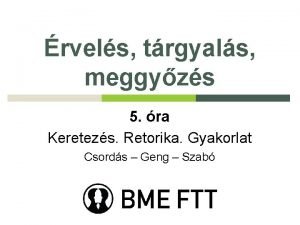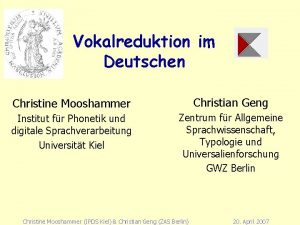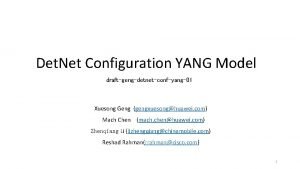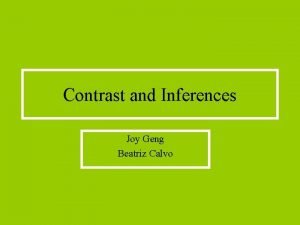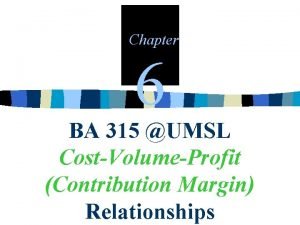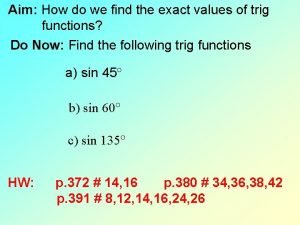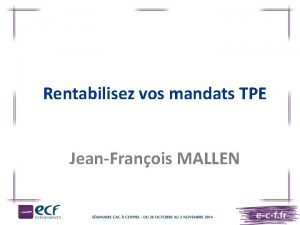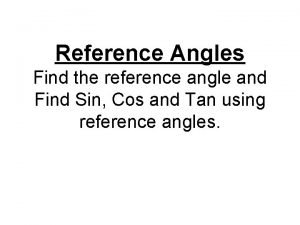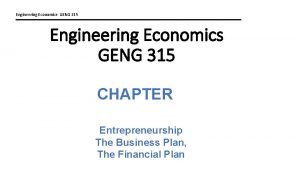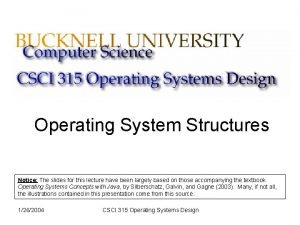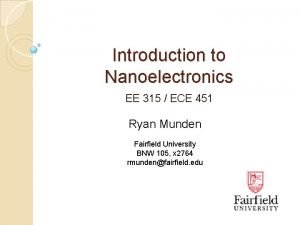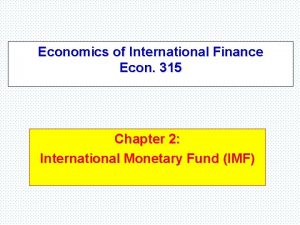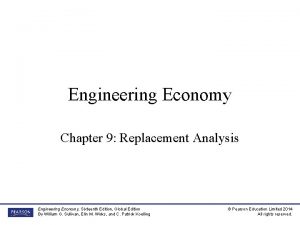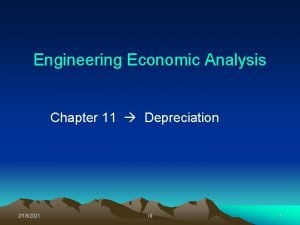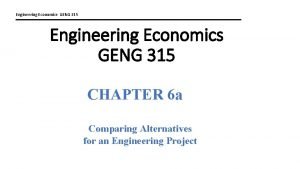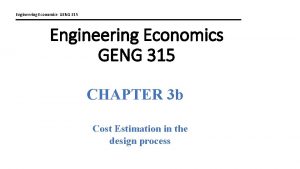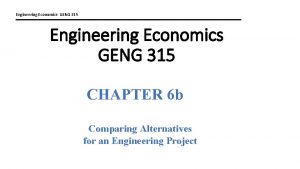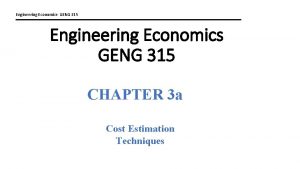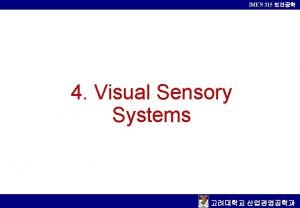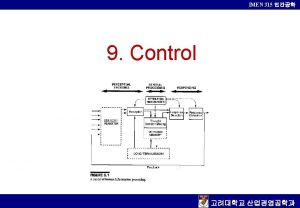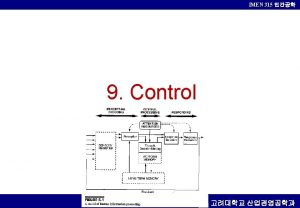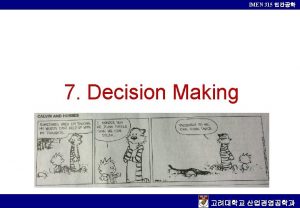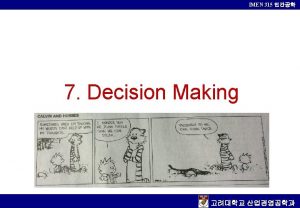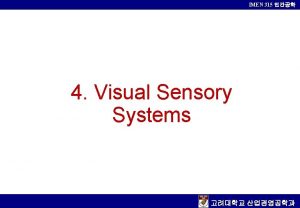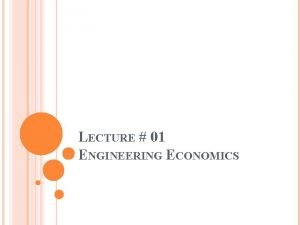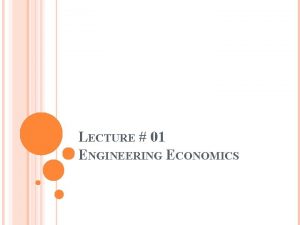Engineering Economics GENG 315 Engineering Economics GENG 315
























- Slides: 24

Engineering Economics- GENG 315 Engineering Economics GENG 315

Engineering Economics- GENG 315 Objectives q Illustrate how basic equivalence calculations are made with respect to the time value of the capital in engineering economy studies (Continued). Dr Muhammad Tariq Shafiq

Engineering Economics- GENG 315 Re-Cap q Definitions: Time Value of Money q The Concept of Interest (Interest Rate / Simple Vs Compound). Simple Interest I = (P)(N)(i), P=? N=? i=? q Cash Flow Diagrams Dr Muhammad Tariq Shafiq

Engineering Economics- GENG 315 Re-Cap If an amount P dollars is invested at a point in time and i% is the interest rate (profit or growth) period, the amount will grow to a future amount F (1) = P +Pi by the end of one period by the end of two periods the amount will be F (2)= P (1+i) + P (1+i) = by the end of N periods the amount will be Dr Muhammad Tariq Shafiq

Engineering Economics- GENG 315 1. Finding F when Given P Where (1+i) N is single payment compound amount factor Ø Numerical values for this factor are given in Appendix C Ø In its functional form, it is (F/P, i%, N) F = P (F/P, i%, N) Dr Muhammad Tariq Shafiq

Engineering Economics- GENG 315 2. Finding P when Given F Where (1+i) –N is single payment present worth amount factor Ø Numerical values for this factor are given in Appendix C P = F (1+i) –N Ø In its functional form, it is (P/F, i%, N) P = F (P/F, i%, N) Dr Muhammad Tariq Shafiq

Engineering Economics- GENG 315 q Interest formulas relating a uniform series (annuity) to its present equivalent and future equivalent values A A 1 2 3 N-2 A A 0 P = Present Equivalent (Find) Ø This cash flow diagram shows the following: N-1 N Period F = Future Equivalent (Find) i = Interest Rate per Period Ø An ordinary annuity which is a series of uniform (equal) receipts/payed, each of amount A, occurring at the end of each period for N periods with interest at i% period. Ø The present equivalent and future equivalent values of the shown annuity are P and F respectively

Engineering Economics- GENG 315 Ø The future equivalent value, F, at the end of the Nth period is obtained by summing the future equivalents of each A of the cash flows. Thus A A A 1 2 3 N 2 N 1 A 0 P = Present Equivalent (Find) F = A (F/A, i%, N-1) + A (F/A, i%, N-2) + ……. . +A (F/A, i%, 0) Period i = Interest Rate per Period N F = Future Equivalent (Find)

Engineering Economics- GENG 315 = Uniform series compound amount factor F = A (F/A, i%, N). = Functional Form

Engineering Economics- GENG 315 3. Finding F when Given A Ø Where [(1+i) N – 1]/ i] is Uniform series compound amount factor Ø Numerical values for this factor are given in Appendix C Ø In its functional form, it is (F/A, i%, N) F = A (F/A, i%, N)

Engineering Economics- GENG 315 4. Finding A when Given F solving for A Ø Where i/[(1+i)N– 1] is Uniform series sunk fund amount factor Ø Numerical values for this factor are given in Appendix C Ø In its functional form, it is (A/F, i%, N) A = F (A/F, i%, N)

Engineering Economics- GENG 315 5. Finding P when Given A Also Ø Where [(1+i) N– 1]/[i(1+i) N] is Uniform series present worth factor for the annuity Ø Numerical values for this factor are given in Appendix C P = A ( P/A, i%, N) Ø In its functional form, it is (P/A, i%, N)

Engineering Economics- GENG 315 6. Finding A when Given P solving for A Ø Where i(1+i)N/[(1+i)N– 1] is Uniform series capital recovery factor Ø Numerical values for this factor are given in Appendix C A = P ( A/P, i%, N) Ø In its functional form, it is (A/P, i%, N)

Engineering Economics- GENG 315 q Finding F when Given P F = P (F/P, i%, N). F = P (1+i) N q Finding P when Given F P = F (P/F, i% , N) P = F (1+i) –N q Finding F when Given A F = A (F/A, i%, N) q Finding A when Given F A = F (A/F, i%, N) q Finding P when Given A P = A ( P/A, i%, N) q Finding A when Given P A = P ( A/P, i%, N)

Ø Where (1+i) N is single payment compound amount factor Ø Where (1+i) –N is single payment present worth amount factor Ø = Uniform series compound amount factor Ø Where [(1+i) N – 1]/ i] is Uniform series compound amount factor Ø Where i/[(1+i)N– 1] is Uniform series sunk fund amount factor Ø Where [(1+i) N– 1]/[i(1+i) N] is Uniform series present worth factor for the annuity Ø Where i(1+i)N/[(1+i)N– 1] is Uniform series capital recovery factor

Money- Time Relationships and Equivalence

Money- Time Relationships and Equivalence




Money- Time Relationships and Equivalence Nominal interest rates and effective/actual interest rates ØIf interest period is less than one year, still the interest rate is quoted on an annual basis, followed by the compounding period if different from one year in length. • For example if the interest rate is 6% per interest period and the interest period is six months, this is quoted as “ 12% compounded semiannually”. • Here, the annual rate of interest (12%) is known as the nominal rate and is represented by, r. However, actual (or effective) annual rate is greater than r (12%), because compounding occurs twice during the year.

Money- Time Relationships and Equivalence ØThe frequency at which a nominal interest rate (r) is compounded each year, is expected to have a pronounced effect on the effective interest, (i) , as given by the following equation: ………(5 -5) Where: M, is the number of compounding periods per year. ØThe effective rate of interest is useful for describing the compounding effect of interest earned on interest during one year.

Money- Time Relationships and Equivalence

 Qp1k84irzpo -site:youtube.com
Qp1k84irzpo -site:youtube.com Christine mooshammer
Christine mooshammer Rise vs geng
Rise vs geng Xuesong geng
Xuesong geng Joy geng
Joy geng School of business and economics maastricht
School of business and economics maastricht Mathematical economics vs non mathematical economics
Mathematical economics vs non mathematical economics Isa 315
Isa 315 Isa 315 revised effective date
Isa 315 revised effective date Cvp graph
Cvp graph Exact value of sin 240
Exact value of sin 240 Tentukan semua balikan dari 9 (mod 11)
Tentukan semua balikan dari 9 (mod 11) Nep 630
Nep 630 How to find reference angle in radians
How to find reference angle in radians Cot 270°
Cot 270° 315
315 Economic 315
Economic 315 Mode of operation
Mode of operation Ee 315
Ee 315 Economic 315
Economic 315 Ba 315
Ba 315 Tentukan volume bola berikut a b c d e f
Tentukan volume bola berikut a b c d e f 315 production
315 production Euac economics
Euac economics Soyd depreciation
Soyd depreciation
